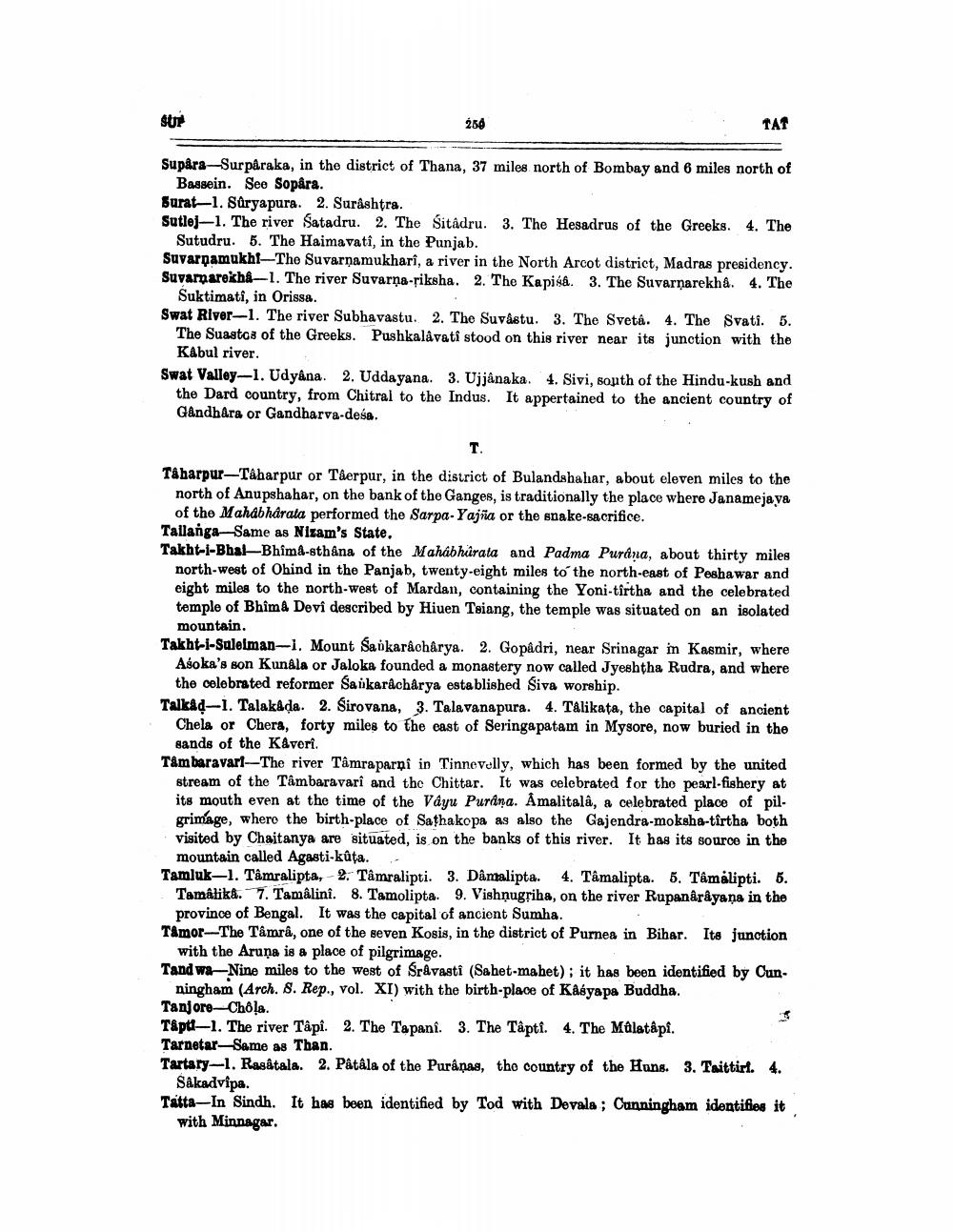________________
SUP
250
TAT
Supâra-Surpâraka, in the district of Thana, 37 miles north of Bombay and 6 miles north of Bassein. See Sopâra.
Surat-1. Suryapura. 2. Surâshtra.
Sutlej-1. The river Satadru. 2. The Sitâdru. 3. The Hesadrus of the Greeks. 4. The Sutudru. 5. The Haimavatî, in the Punjab.
Suvarnamukhi The Suvarnamukharî, a river in the North Arcot district, Madras presidency. Suvarnarekha-1. The river Suvarna-riksha. 2. The Kapisa. 3. The Suvarnarekhâ. 4. The Suktimati, in Orissa.
Swat River-1. The river Subhavastu. 2. The Suvâstu. 3. The Sveta. 4. The Svati. 5. The Suastos of the Greeks. Pushkalâvatî stood on this river near its junction with the Kabul river.
Swat Valley-1. Udyâna. 2. Uddayana. 3. Ujjânaka. 4. Sivi, south of the Hindu-kush and the Dard country, from Chitral to the Indus. It appertained to the ancient country of Gandhara or Gandharva-desa.
T.
Taharpur-Taharpur or Tâerpur, in the district of Bulandshahar, about eleven miles to the north of Anupshahar, on the bank of the Ganges, is traditionally the place where Janamejaya of the Mahabharata performed the Sarpa-Yajña or the snake-sacrifice. Tallanga Same as Nizam's State.
Takht-i-Bhai Bhima-sthâna of the Mahabharata and Padma Purana, about thirty miles north-west of Ohind in the Panjab, twenty-eight miles to the north-east of Peshawar and eight miles to the north-west of Mardan, containing the Yoni-tirtha and the celebrated temple of Bhima Devi described by Hiuen Tsiang, the temple was situated on an isolated mountain.
Takht-i-Suleiman-i. Mount Sankaracharya. 2. Gopadri, near Srinagar in Kasmir, where Asoka's son Kunâla or Jaloka founded a monastery now called Jyeshtha Rudra, and where the celebrated reformer Sankaracharya established Siva worship.
Talkaḍ-1. Talakaḍa. 2. Sirovana, 3. Talavanapura. 4. Talikata, the capital of ancient Chela or Chera, forty miles to the cast of Seringapatam in Mysore, now buried in the sands of the Kâveri.
Tâmbaravari-The river Tâmraparni in Tinnevelly, which has been formed by the united stream of the Tâmbaravari and the Chittar. It was celebrated for the pearl-fishery at its mouth even at the time of the Vayu Purana. Amalitala, a celebrated place of pilgrimage, where the birth-place of Sathakopa as also the Gajendra-moksha-tirtha both visited by Chaitanya are situated, is on the banks of this river. It has its source in the mountain called Agasti-kûta.
Tamluk-1. Tâmralipta, 2. Tâmralipti. 3. Dâmalipta. 4. Tâmalipta. 5. Tâmȧlipti. 5. Tamâlika. 7. Tamâlinî. 8. Tamolipta. 9. Vishnugriha, on the river Rupanârâyana in the province of Bengal. It was the capital of ancient Sumha.
Tâmor-The Tâmrâ, one of the seven Kosis, in the district of Purnea in Bihar. Its junction with the Aruna is a place of pilgrimage.
Tand wa-Nine miles to the west of Sravastî (Sahet-mahet); it has been identified by Cunningham (Arch. 8. Rep., vol. XI) with the birth-place of Kasyapa Buddha. Tanjore Chôla.
Tapt-1. The river Tâpî. 2. The Tapani. 3. The Tâpti. 4. The Mûlatâpî. Tarnetar-Same as Than.
Tartary-1. Rasâtala. 2. Pâtâla of the Purânas, the country of the Huns. 3. Taittiri. 4. Sakadvipa
Tatta-In Sindh. It has been identified by Tod with Devala; Cunningham identifies it with Minnagar.




